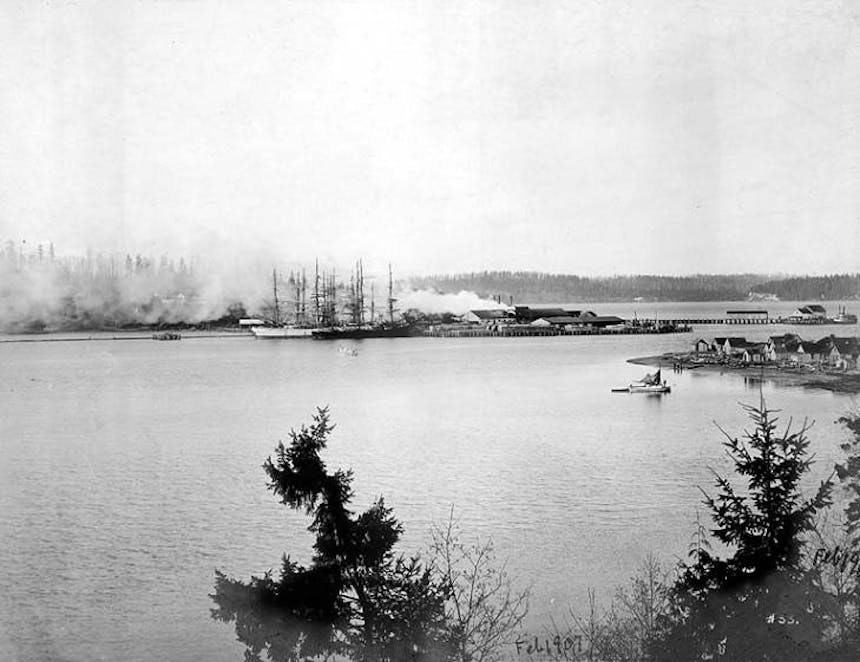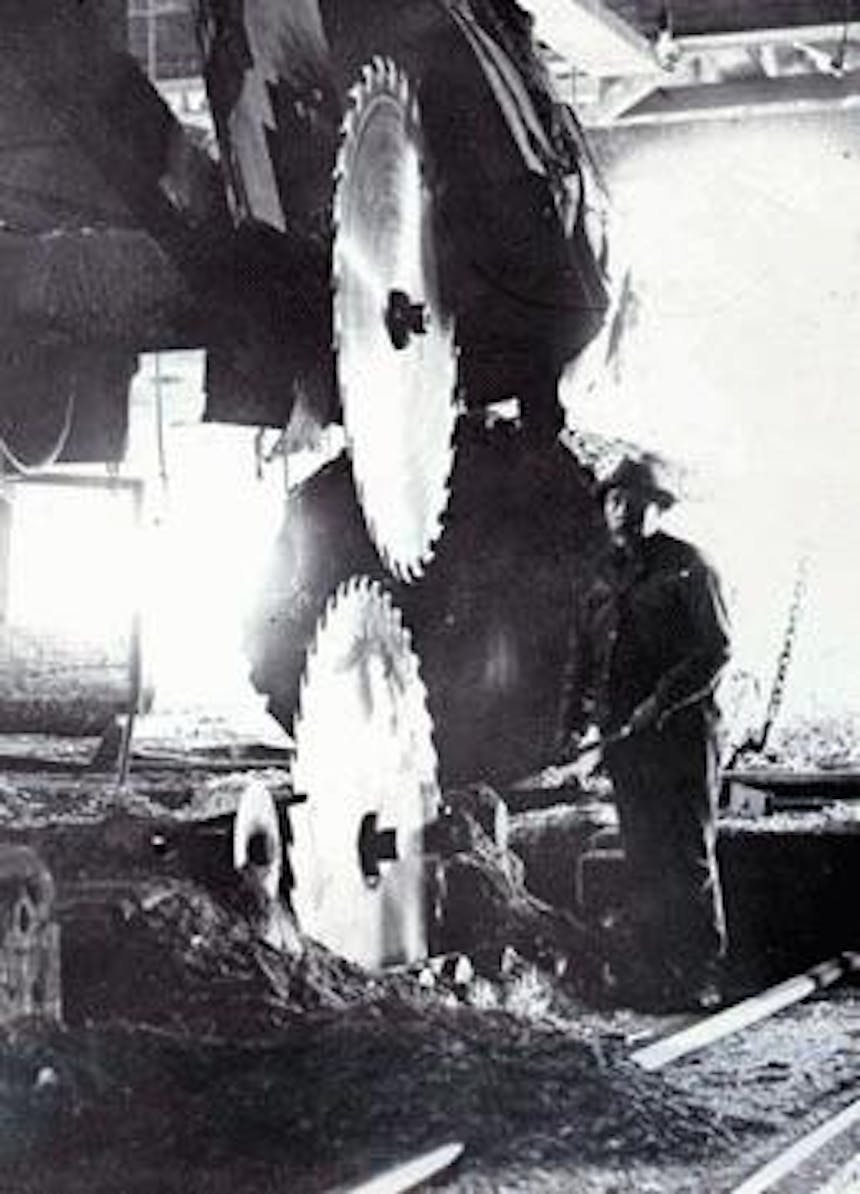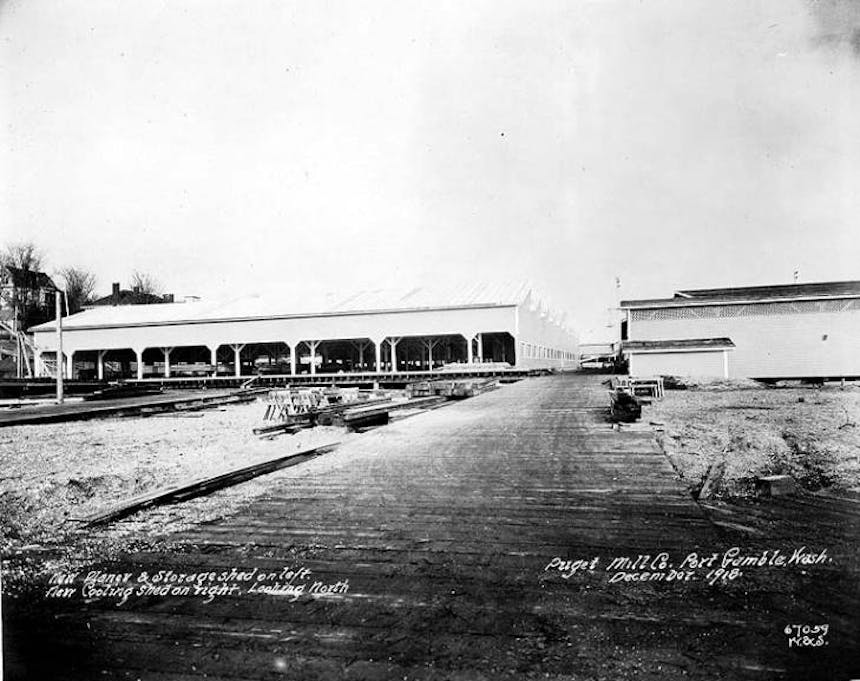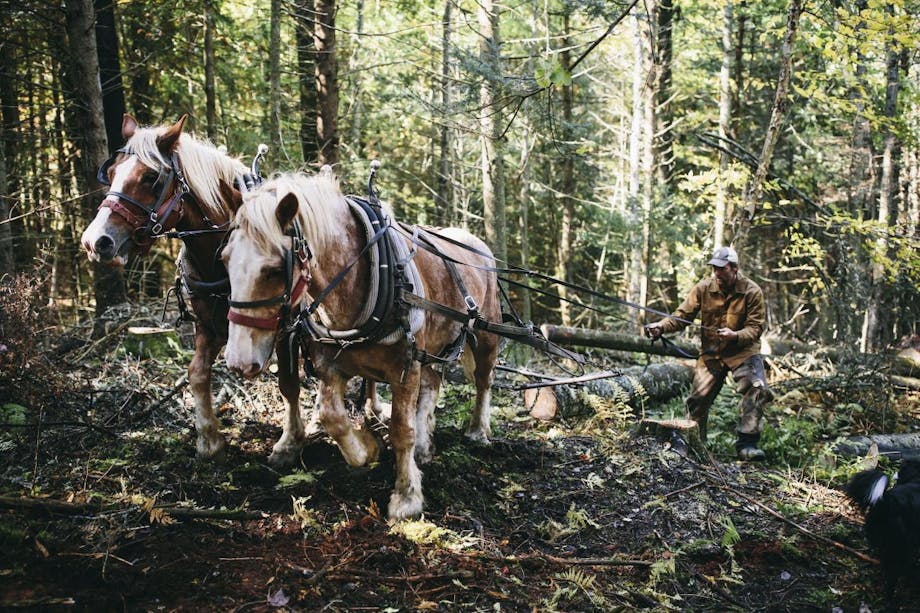The clink of cable links rings out with every few inches of log yanked up the wooden ramp to the sawmill’s entrance. The freshly fallen, limbed, and bucked tree has hooks digging into the ends, pulling it into place to be cut to size. One man dressed in wool flannel fatigues drives two large spikes through a wooden block to hold the log in place. Another man, with a rolled cigarette dangling and pursed from his mustachioed lips, places can’t hooks on the log. With his sleeves rolled up, his rippled forearms move the handle as the timber twists into place. Then another man turns a tiller that lifts the dam levy as water flows, forcing the wagon wheel to spin. With each turn of the wheel, the muley saw goes up and down buzzing the log. Hints of vanilla, citrus, pinesap, and freshly cut wood are released as the teeth tear out each woodchip. The irregular log is pulled through the saw, shaving off the bark and shaping it slowly into a dimensional board plank. Sawdust piles up.
Port Gamble was a gamble that paid off for 142 years as the longest continuously running sawmill on the North American continent. Like many logging towns, it faced boom years and bust years but was far more successful than most. New England influenced the creation and construction of the town. The merchants Andrew Pope and William Talbot sailed west from Maine to San Francisco seeking large resources of timber to supply the growing demand of an ever-growing American West.

The AMARANTH was a four-masted American barkentine out of San Francisco. It was built in 1901 M. Turner, Benicia, California and wrecked in 1913. University of Washington Libraries, Special Collections, HES367
In 1849, the California Gold Rush lured many people west seeking fortune. As many transients migrated from east to west, the country expanded at its seams into new vistas. Pope and Talbot arrived in San Francisco from East Machias, Maine, in hopes of capitalizing on the growing lumber and shipping industries. Knowing that it would be a very lucrative business venture, they wanted to be at the forefront of shipping lumber for the rapidly growing western United States, and specifically California. Very quickly, they realized that lumber supply from New England was not enough to meet the growing demand for building commodities. Soon they heard word that the Oregon Territory had coniferous forests packed densely like the hairs on a dog. They soon partnered with Josiah Keller and Charles Foster, and together they created the Puget Mill Company.

Point Julie and Puget Mill Co., Port Gamble, Washington, February 1907. University of Washington Libraries, Special Collections, WAS0807
During one summer four years later, Talbot set sail exploring the coast north of Oregon and into Washington. He found an excellent location for a mill within the sandy shores of Hood Canal, at the mouth of Gamble Bay. Its strategic location—near abundant timber and well-situated for shipping dimensional lumber to California—was perfect for a millsite. Keller soon sailed north and joined him with a boiler, engine, and muley saw for the mill. The mill was cutting dimensional lumber by that autumn.
They had a working mill, but workers were hard to come by because of the area’s remote location. The Pacific Northwest was still frontier territory in the 1850s. Fortunately, Charles Foster was able to recruit experienced mill workers from East Machias with the promise of a new job and steady year-round work to come west to Gamble Bay. Water sawmills in Maine shut down for extended periods in the winter because streams froze. However, the climate along Washington’s coast was milder and didn’t face the same struggles. Workers soon arrived but grew homesick because there was no community and the job was labor-intensive. To help the migrant workers feel more at ease, houses, general stores, taverns, and St. Paul’s Episcopalian church were built in traditional New England style.

Double circular saws at Port Gamble Mill, and saw filer James A. Thompson, ca. 1905. Photo provided by Port Gamble Museum Archives (Neg. 609-12)
In 1942, Commodore Wilkes named the area Port Gamble. However, the region was formerly known by the South Coast Salish as “Teekalet.” The region’s first inhabitants had lived there since 2400 B.C. Many of them moved across the bay to a town called Little Boston, while some stayed on to work at the mill.
As Port Gamble continued to succeed, it had a growing need for timber to feed the insatiable appetite of the continually expanding West. As more and more states depleted their timber supplies, more companies turned their eyes toward Washington, and by 1906 there were more than 900 lumber mills within the state. Many companies set up tree farms from which to harvest.
The Puget Mill Company of Port Gamble became an international industrial powerhouse by shipping lumber all around the world—everywhere from Shanghai to Cape Town, South Africa. By 1862, it owned a fleet of 10 vessels and shipped nearly 19 million board feet of lumber to 37 other ports around the world. Because of Pope and Talbot’s connection to Maine and the East Coast, they had many ports along South America and the West Indies.

New Planer and Storage shed on left. New Cooling Shed on right. Looking north. Puget Mill Co. Port Gamble, Wash, December 1918. University of Washington Libraries, Special Collections,IND0275.
Seventy-five years after the genesis of the company, the board of directors met to discuss selling it off. The early 1900s were a trying time for the region’s lumber industry because the state of Washington instituted a tax increase on timber acreage held by all sawmill companies. This tax—along with the mill’s outdated, inefficient equipment and dilapidated buildings—burdened Talbot. They decided to sell the company to Charles McCormick for $15 million. In the agreement, operations had to continue, and McCormick had to build a brand-new mill at Port Gamble.
McCormick’s company had very little luck and went into increasing debt with the cost of modernizing and improving the Puget Mill Company. He still owed $7 million to the original owners but couldn’t make payments and was forced to return all of the company holdings to the principals of the foreclosure suit filed against him. McCormick had to sell the company back to Pope’s descendants.
Today, most of the town is still owned and maintained by the mill as a historic site with traditional colonial architecture. Currently, Port Gamble is a National Historic Landmark. The mill no longer runs, but its impact on the village, surrounding area, and even the world remains. In the end, the gamble was worth it.



